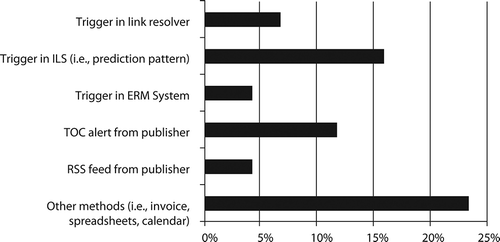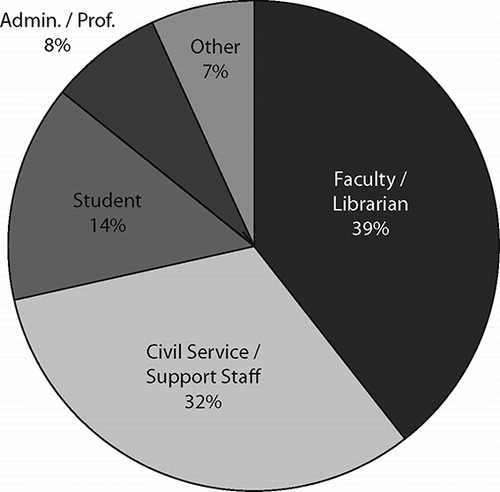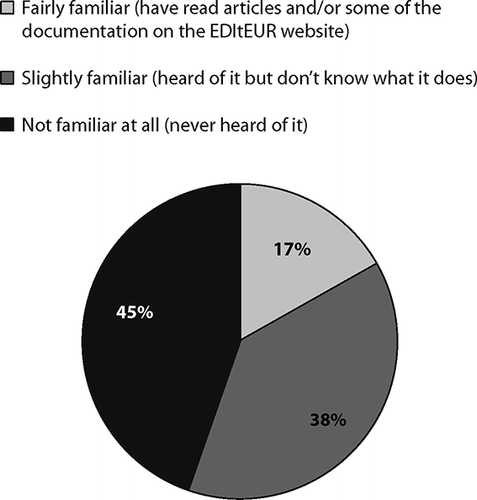Abstract
A 2009 survey conducted by librarians at Southern Illinois University Carbondale revealed that librarians want an automated process for verifying online serial access. Rather than just waiting for automation to arrive, 51 percent of the 237 respondents were systematically checking access to subscribed online journals. Unfortunately, 45 percent of respondents had never heard of ONIX (ONline Information eXchange) for Serials, the group of XML formats for sharing serial product and subscription information that holds promise for enabling this automation. Presenters shared the survey results and noted what needs to be done next to put ONIX for Serials into practice.
INTRODUCTION
Libraries have a long history of verifying receipt of subscribed serial issues. In the past, print issues arrived at the library and the staff had an option to keep track of received issues, claim missed issues, and generally verify which issues of what subscribed journals were available to library users. In the online environment there are no print issues arriving in the mail to trigger these types of actions. Many libraries are reactive and only check online journal accessibility in response to problems as they arise. Others have decided to play a more proactive role and created some internal methods for systematically checking access, rather than relying on library users to alert them to problems.
BACKGROUND
At Southern Illinois University Carbondale (SIUC), an adaptation of the print journal check-in workflow was established for e-journals in 2007, similar to the one described by Yesilbas and Schwartzkopf.Footnote 1 A mechanism was set up to trigger the action of checking access for online-only journal titles (not aggregated titles) through creating artificial prediction patterns in the integrated library system (ILS) that sent alerts of missed issues (i.e., expected issues not checked in). The alerts were routed to a staff member who then used the library's link resolver and the subscription agent's information to look up the journal and check access to the earliest and latest entitlements on the publisher's website.
Even though the procedure seemed to be working fairly well, there were still questions about whether the established check-in process was the most efficient way of checking access. Most notably, development of the ONline Information eXchange (ONIX) for Serials XML formats, particularly the Serials Release Notification (SRN), offers promise for automating the process. SIUC librarians decided to conduct a survey to determine current library practices at other institutions. There are four main questions they wished to answer:
| 1. | How many libraries systematically check access to subscribed online journals? | ||||
| 2. | What methods are used for checking access? | ||||
| 3. | What is the level of knowledge and interest in ONIX for Serials? | ||||
| 4. | What are the perceptions of the effects of SRN on current methods of checking access? | ||||
Practical experience had revealed that initiating systematic checking required three basic elements: setting up a trigger/tracking mechanism of some kind to determine when to check titles and to track progress; determining a verification methodology for where to go to check and what constitutes verified access; and assigning tasks for doing the initial checking and resolving problems that are encountered, including providing training for staff members.
A literature search revealed a very small body of work on this topic. Two articles dealt with the transition from checking in print journal issues to managing online access. Both discussed the reasoning behind the historic practice of checking in print serial issues and the effect on that reasoning of the online environment. Anderson and Zink questioned the importance of traditional check-in processes such as recording whether issues have arrived or not, tracking binding of print, and detecting changes in title, publisher, and publication frequency.Footnote 2 In an online environment the first two become irrelevant and the latter can be determined through other means besides checking in each issue. However, Carr pointed out that the objectives of the print-based check-in, including informing users about content availability, maintaining bibliographic control, and acting as stewards of monetary investment, continue in the online environment.Footnote 3 However, these processes happen through new practices and added complexity, often on a macro level rather than at the title level.
A survey instrument was created using an open-source survey application called LimeSurvey, and permission was requested and received through SIUC's Human Subjects Committee to conduct the study. A request for participation was e-mailed to the following discussion lists: SERIALST, ERIL-L, LIS-E-Resources, ACQNET-L, and the Illinois statewide consortia list for electronic resources. The survey was made available for two weeks in May 2009.
The survey application included a tool for analyzing results as well as an option to pull results into a spreadsheet. The latter method was selected to allow evaluation of respondent comments as well as statistical data. Answers were coded during analysis, taking into consideration the relationship between answers and comments on several of the questions.
SURVEY RESULTS
Demographics
Overall, 237 responses were received with 74.7 percent of the surveys completed by librarians. Of the respondents, 98.73 percent subscribed to online journals. Journal budget size varied, with the largest groups in the $1 million to $5 million range (35.86 percent) and the $100,000 to $499,999 range (31.22 percent). The remaining categories were less than $100,000 for 14.77 percent of respondents, $500,000 to $999,999 range for 13.92 percent respondents, and over $5 million for just 4.22 percent. The portion of the journal budget spent on online-only journals was fairly evenly distributed among the ranges (anywhere from less than 25 percent to 100 percent).
Chi-square correlations were performed on various groups of data. Only one statistically significant correlation was found. This was between the size of budget and the percentage of budget spent on online-only journals (chi-square p-value greater than .0001). Libraries with a smaller budget were found to be more likely to spend a smaller percentage of their budget on online-only journals than libraries with larger collection budgets.
Online Access Checking Methods
The survey results showed that out of 237 respondents, 51 percent were checking online access systematically. Most respondents indicated their libraries did not have the time and resources to check online access frequently, with 50 percent checking access annually, 18 percent biannually, and only 9 percent checking access according to publication pattern (see ). Comments indicated that annual checking is often tied to subscription renewal time.
Determining when to perform an annual check is problematic because different publishers adjust their subscription information at different times of the year. The online collections of those who checked according to publication pattern varied in size with most using their integrated library system (ILS) as the trigger prompting the online access check.
Systematic checking requires some kind of a trigger mechanism prompting library staff to check a new batch of titles. The survey showed that 57 percent of respondents work in libraries using the following triggers or a combination of triggers: link resolver, ILS, electronic resource management (ERM) system, table of contents (TOC) alerts, Really Simple Syndication (RSS) feeds provided by publishers, locally created spreadsheets, calendar reminders, or the subscription agent's invoice (see ). The single most often used trigger was the ILS, while only 10 percent of respondents with an ERM system used it as the trigger for online checking.
Verifying Online Access
Many publishers and platforms provide access to library administrative accounts where librarians can view or download the library's online journal holdings. Some publishers or platforms only provide a title list while others include coverage start and end dates, entitlement start and end dates, and title changes. Some platforms offer an HTML (Web page) view only, while others may allow downloading of CSV, Excel, or XML files. Overall, there are no standards for expressing library holdings information and often the information presented on the administrative site is confusing. This may explain why only 24 percent of respondents check publisher's holding information to verify online access.
Twenty-seven percent of respondents used their subscription vendors' information to verify access, while 46 percent of respondents indicated that they checked the journal websites for visual indicators (i.e., different icons that appear either at the journal, volume, or issue level indicating access). On many publishers' sites, however, there are no visual indicators and opening the HTML or PDF version of an article is the only way to verify access. This method of verification was used by 79 percent of respondents. Even though this method requires the least amount of expertise, it is without doubt the most time consuming verification method.
Staffing Issues
Ideally, libraries should utilize a kind of triage system where the first round of checking is performed by lower-level staff. However, survey respondents reported that the first round of checking was often performed by higher-level staff; 39 percent indicated that faculty/librarians were doing the first round of checking, as opposed just 14 percent indicating the use of student workers (see ). It is possible that the libraries using faculty/librarians for first round checking have not yet reallocated staff and student workers to electronic resource management, or have fewer staff, and the librarians have to wear many hats.
A more efficient workflow would require the involvement of higher-level staff only when problems arise in the first round of checking. In the survey, 61 percent of respondents indicated that faculty/librarians are the ones who are resolving access problems in their libraries. Since problems and solutions to those problems are wide ranging and require expertise, allocating professional librarians for these tasks seems appropriate.
Satisfaction with Established Processes
Respondents were asked to rate their satisfaction with their online checking methods. Only 13 percent indicated that their current system was working very well. Fifty percent said it was working fairly well but could be improved, and 36 percent indicated it was not working very well but was better than nothing.
Statistical analysis revealed no correlations between checking methods, staffing levels, online journal collection size, use of electronic resource management tools, and level of satisfaction, so that it is not possible to ascertain any best practices, even for those who responded that their system was working very well.
Familiarity with ONIX for Serials
The survey asked about familiarity with ONIX for Serials. Forty-five percent of respondents indicated that they had never heard of it and only 17 percent indicated that they are fairly familiar with it (see ). When asked about familiarity with SRN, the percentage of librarians who were not familiar with it at all was even higher (64 percent). Still, 45 percent said they were fairly or very interested in automated notification of new online issue availability (such as through SRN Issue Notice), with another 38 percent indicating they were slightly interested. Since so few knew anything about SRN, responses to the question of what effect SRN might have on current methods of checking access were not applicable.
ONIX FOR SERIALS
ONIX for Serials is a family of XML formats for communicating information about serial products and subscription information. In 2002, a joint working party (known as the JWP), supported by both NISO and EDItEUR (an international group that coordinates standards for book and serial e-commerce), was established to identify required information and develop XML schemas accordingly. The JWP defined three ONIX for Serials formats: the Serials Online Holdings (SOH) format, used to transmit holdings information for online serials (volumes, issues, and dates included in a particular subscription); the Serials Products and Subscriptions (SPS) format, used for communicating information about serial subscription products (with or without price information); and the Serials Release Notification (SRN) format, used for communicating information about the publication or electronic availability of one or more serial releases. All of these are XML formats and for each there is an XML schema, an overview document, and a detailed user guide explaining every single data element available on the EDItEUR website.Footnote 4
Serials Release Notification (SRN) transmits information about the “publication” (that is, the electronic availability) of serial releases. There are three separate messages in the SRN format; they are additive with each conveying more information than the previous one. The baseline message is the Issue Notice, used to announce a new release. The Issue Notice contains metadata for the serial version (i.e., the particular manifestation of a serial work such as the online or print version), including identification (usually ISSN), basic bibliographic information for the work, and medium. It also contains a description of the issue being released, including type of release (normal, index, supplement, etc.), identification of the release (e.g., Serial Item and Contribution Identifier), enumeration, chronology (cover date), release date (confirmed date of release), and the URL of the release (the URL of the issue itself).
As of this writing, the SRN Issue Notice is in its pilot version. Once EDItEUR has received feedback about its usability, it will move to a production version and, hopefully, that will be adopted by the serial community. One problem for any data communication format standard is the fear that an organization will put a lot of work into developing it only to find no one wants to use it. Another problem is that the SRN format appears long and complicated. In actuality, the SRN format covers all necessary cases (from which parties can pick what they need) and, within those constraints, it has been made as simple as possible.
WHAT IS THE PROMISE OF SRN?
As stated earlier, the survey revealed interest in automated notification of new online issue availability. Respondents overwhelmingly stated the need for an automated, electronic process for keeping serials holdings data up-to-date that can be monitored by someone with little training (e.g., a student worker) and not cost very much, if anything.
Librarians want consistent, reliable, and standardized holdings information. Often publishers' and subscription agents' records do not agree. The subscription entitlement information for a particular library needs to be consistent and reliable in a standardized format. Respondents want notifications about changes to coverage or terms of agreement to be timely and automated, especially for the most critical changes that result in loss of access.
Comments also indicated that what libraries really need is an automated way of checking access, not just entitlement. Manually checking for icons or opening PDFs is too labor intensive. In an article about patron-centered practices for serialists, Anderson noted that libraries need workflows that place priority on online access, are automated, and are tolerant of minor error.Footnote 5 Libraries have gotten the message about the first part, are working on the last part, but need help from vendors, subscription agents, and publishers for the middle part.
The hoped for scenario is that the publisher or online content hosting system sends out a broadcast message every time a new issue is released or about to be released. The local ILS or ERM system ingests the message and saves the relevant data, which include the URL of the issue. Using the URL found in the message, the local system automatically checks the website to see if the issue is there. If not, it sends an access claim to the subscription agent or publisher, who then resolves the access problem. If the message is robust enough, it can be used to update the link resolver knowledgebase, update the catalog holdings information with the latest issue received, and announce notices about new issues to patrons. All with no manual intervention by the library!
CONCLUSION
Comments made in the 2009 SIUC survey revealed an expectation by some respondents that once online access was set up, it would continue working and that patrons would notify staff if it was not (at which point staff could presumably correct the problem). Practical experience of many libraries reveals neither of these to be the case (i.e., access does not always keep working and patrons do not necessarily tell you when it is not). A proactive approach to the situation is to systematically check online access. The main reason given by survey respondents for not doing systematic checking was lack of staff time.
Respondents indicated the need for standardized holdings information; an automated, electronic process for keeping serials holdings data up-to-date; and an automated way of checking access. ONIX for Serials XML messages provide a standard formatted message that any provider can produce and any system receive. The SRN Issue Notice holds promise for future automation of both entitlement and access verification for online serials.
What needs to be done next? Librarians need to communicate clearly to publishers, subscription agents, and vendors what they need and want. Link resolver and A–Z list vendors also need to communicate their interest in receiving standardized data. Publishers need to provide accurate, current information to agents, vendors, and librarians using the new standardized formats. Subscription agents need to provide tools to help librarians, publishers, and vendors verify and work with information transferred through standardized formats. ERM systems and ILS acquisition modules need to accept standard data formats and act on them. ONIX for Serials holds the promise of an automated system for handling a basic library need of verifying access to subscribed serial issues in an online environment.
Notes
1. Amanda Yesilbas (presenter) and Becky Schwartzkopf (recorder), “Old Is New Again: Using Established Workflows to Handle Electronic Resources,” Serials Librarian 52, no. 3/4 (2007): 277–280, doi:10.1300/J123v52n03_05.
2. Rick Anderson and Steven D. Zink, “Implementing the Unthinkable: The Demise of Periodical Check-In at the University of Nevada,” Library Collections, Acquisitions, & Technical Services 27, no. 1 (Spring 2003): 61–71, doi:10.1016/S1464-9055(02)00309-3.
3. Patrick L. Carr, “The Claim: Staking Out New Practices for Achieving the Objectives of Check-In,” Serials Librarian 51, no. 1 (2006): 73–81, doi:10.1300/J123v51n01_04.
4. EDItEUR, “ONIX for Serials,” http://www.editeur.org/onixserials.html (accessed July 17, 2009).
5. Rick Anderson, “It's Not About the Workflow: Patron-Centered Practices for 21st-Century Serialists,” Serials Librarian 51, no. 3/4 (May 2007): 189–199, doi:10.1300/J123v51n03_13.



